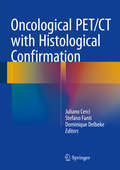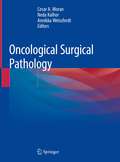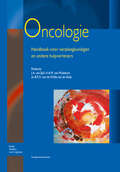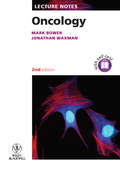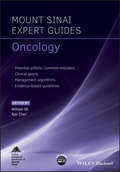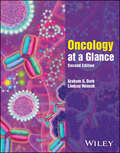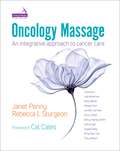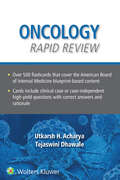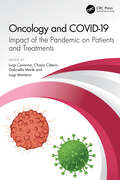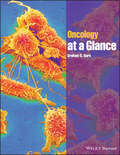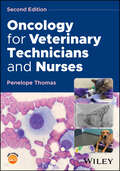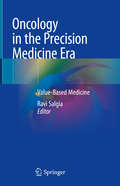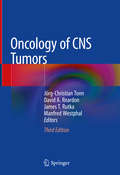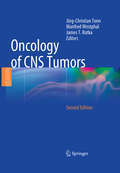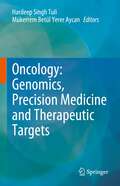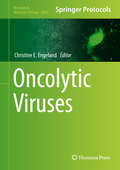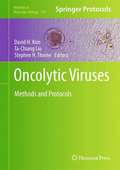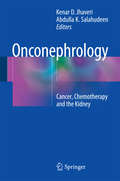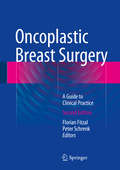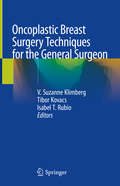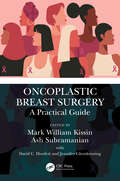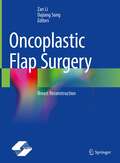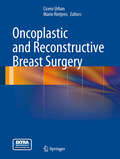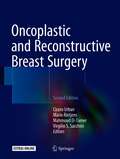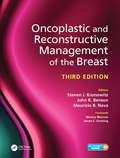- Table View
- List View
Oncological PET/CT with Histological Confirmation
by Dominique Delbeke Stefano Fanti Juliano CerciThis book reviews the important new field of PET/CT-guided biopsy, which is of potential value in optimizing the diagnostic yield of biopsies. The role of this technology is examined in a range of malignancies, including lymphoma, pancreatic, breast cancer and CNS malignancies. True positive and false positive cases are presented and discussed, and many aspects of PET and pathology are addressed. The book describes many case presentations illustrated with mostly 18F-FDG PET/CT images, but also other PET radiopharmaceuticals such as 18F-FLT. The three editors are expert nuclear medicine physicians from Europe and North and South America, and the range of experiences gained in using PET/CT across the globe is reflected in the book.
Oncological Surgical Pathology
by Annikka Weissferdt Cesar A. Moran Neda KalhorThis text provides the necessary tools and up-to-date information on the morphological approach and most current use of ancillary techniques in the diagnosis and treatment of malignant tumors. The work is divided by sub specialty areas so that the reader can easily obtain the information desired. Features of histopathological lesions are presented in each area, as well as an up-to-date use of the different immunohistochemical stains and molecular biology features, when applicable, which are commonly used to determine treatment modalities. All sub specialty sections are written by sub specialty pathologists with experience in tumor pathology and who work in a cancer center. Each chapter is richly illustrated and properly referenced. Oncological Surgical Pathology will be of use not only for pathologists (including pathology residents and fellows), but also for oncological surgeons, oncologists and interventional radiologists.
Oncologie: Handboek voor verpleegkundigen en andere hulpverleners
by B.F.H. van Walle-van de Geijn H.A.M. van Muilekom J.A. van SpilEen vooral door oncologieverpleegkundigen en medisch specialisten geschreven handboek over alle gebieden binnen de oncologie waar de verpleegkundige mee te maken kan krijgen.
Oncology
by Jonathan Waxman Mark BowerCancer is one of the most rapidly changing areas of medicine, affecting ever-increasing numbers of people, and this new edition of Lecture Notes: Oncology brings together all the information a medical student or graduate clinician needs in one accessible volume. It covers the scientific basis and social impact of cancer, describes the origins and presentations of cancer on a regional and system basis, and discusses the fundamentals of oncology treatment and patient management. Including a new section on epigenetics, clinical vignettes, clear illustrations, tables and diagrams, as well as a self-test section of MCQs, Lecture Notes: Oncology provides core knowledge for professionals involved in cancer care.
Oncology (Mount Sinai Expert Guides)
by William K. Oh Ajai ChariThe Mount Sinai Expert Guides provide quick access to point-of-care specialist clinical information for physicians across a range of therapeutic areas. For each specialty area, the guides emphasize: • Common pitfalls in diagnosis and management • How to prevent complications • Diagnostic and treatment algorithms • Key scientific trials • Evidence-based clinical content • Major society guidelines in order to summarize the very latest in diagnosis and management of diseases and related symptoms. Edited by renowned specialists from the Icahn School of Medicine at Mount Sinai, key faculty members provide the content for all chapters. To ensure consistency within each book and the series as a whole, chapters follow a unified structure throughout. Bonus features such as online case studies with related questions for self-assessment, key patient advice, and ICD codes are provided via the series companion website. Each guide also has its own mobile app available for purchase, allowing you rapid access to the key features wherever you may be.
Oncology At A Glance (At a Glance)
by Graham G. Dark Lindsay HennahThe market‐leading at a Glance series is popular among healthcare students and newly qualified practitioners for its concise and simple approach and excellent illustrations. Each bite‐sized chapter is covered in a double‐page spread with clear, easy‐to‐follow diagrams supported by succinct explanatory text. Covering a wide range of topics, books in the at a Glance series are ideal as introductory texts for teaching, learning and revision, and are useful throughout university and beyond. Everything you need to know about Oncology… at a Glance! Discover a comprehensive, newly-revised edition of Oncology at a Glance! Oncology at a Glance demystifies the complexities of cancer biology and treatment for medical students and junior healthcare practitioners. With updated content including emerging therapies, multidisciplinary team approaches, and palliative care, Oncology at a Glance, Second Edition bridges gaps in the often-fragmented exposure to oncology during clinical training. Real-world case studies and accompanying exercises deepen comprehension, enhance understanding, and support problem-solving in oncology practice. Ideal for foundational learning or a quick refresher in clinical practice, Oncology at a Glance, Second Edition: Consolidates key information into concise sections on individual cancers and broader oncological principlesCovers foundational cancer biology, investigation, clinical management, and key human issues such as communication and palliative careIncludes multiple-choice questions, self-assessment exercises, and a companion website with interactive self-testing features Developed with feedback from medical students to ensure relevance and clarity, Oncology at a Glance, Second Edition remains a must-have for undergraduate medical students, nursing students, junior doctors, and allied health professionals. All content reviewed by students for students Wiley Health Science books are designed exactly for their intended audience. All of our books are developed in collaboration with students. This means that our books are always published with you, the student, in mind. If you would like to be one of our student reviewers, go to www.reviewnursingbooks.com to find out more. This title is also available as an e-book. For more details, please see www.wiley.com/buy/9781394292691
Oncology Massage: An integrative approach to cancer care
by Janet Penny Rebecca SturgeonIn Oncology Massage - an integrative approach to cancer care the authors have created a textbook which will provide both experienced and inexperienced therapists with a resource to expand their knowledge and understanding of working with people with cancer. Cancer occurrence and survivorship are now so common that every massage therapist will at some time work with clients who have been through cancer treatment. The short and long-term effects of biomedical cancer treatment require massage therapy adaptations to pressure, site, position and duration to provide safe and effective treatments. Informed massage therapists can support the body to promote overall wellness as well as identify the underlying secondary effects of cancer treatment that contribute to physical dysfunction.Oncology Massage: An Integrative Approach to Cancer Care provides massage therapists with essential information for:Treatment planning based on the physiology of cancer and cancer treatmentsCritical, thoughtful treatment decision makingConsideration of the psychosocial effects of cancerEnhancing therapist self-awareness and building a therapeutic relationship.The information is presented in a clear and simple format with plentiful use of illustrations and information boxes which allows it to be used both as a learning tool for those new to the field of oncology massage and as a resource for quick referral when working with new patients.The techniques of massage therapy change very little; it is the knowledge and understanding of their use that distinguishes a massage therapist. Oncology Massage is unusual in that it includes contributions not only from a range of experienced practitioners but also from people with cancer who have received massage during and after cancer treatment. This feedback from clients provides an invaluable addition to the understanding of how massage can be used as a safe and effective part of cancer care.
Oncology Rapid Review Flash Cards
by Utkarsh Acharya Tejaswini M DhawaleFace the oncology board exam with confidence! Oncology Rapid Review, created and edited by Drs. Utkarsh H. Acharya and Tejaswini Dhawale, is a conveniently portable, effective review tool that helps you prepare for this comprehensive and challenging exam. Sturdy, full-color flash cards provide a focused, case-based review anytime, anywhere.
Oncology and COVID 19: Impact of the Pandemic on Patients and Treatments
by Luigi Cavanna Chiara Citterio Gabriella Marfe Luigi MontanoThose affected by cancer or receiving cancer treatment have often been more susceptible to infections due to coexisting chronic diseases, overall poor health status, and systemic immunosuppressive states caused by both cancer and anticancer treatments. This pioneering text is an introduction to the key topics in the relationship between infection, pollution, and cancer and is an invaluable resource for residents and junior faculty in Oncology facing the practical problems arising and for those still in training. *Looks at the lessons to be learned for future Oncology patients from a series of studies. *Presents relevant international experience from Oncology clinicians and researchers. *Brings together input from different countries, systems, and specialties.
Oncology at a Glance
by Graham G. DarkThis brand new title in the market-leading at a Glance series brings together fundamental information on cancer biology and treatment to provide a holistic understanding of oncology. It explores both relevant scientific content and key human issues, including communication and palliative care.Oncology at a Glance:* Provides an accessible overview of the scientific foundation of cancer medicine* Covers the common cancers as well as key information on presentation and approaches to investigation and management* Includes young adult oncology, the multidisciplinary team, clinical trials in oncology, approach to treatment and response assessment, management of nausea, and end-of-life care* Was developed with students for students, to ensure it contains exactly what students need to knowOncology at a Glance is an ideal guide for medical students and foundation-year doctors as well as any other healthcare professionals looking to consolidate their knowledge of oncology.
Oncology for Veterinary Technicians and Nurses
by Penelope ThomasComprehensive, straightforward oncology learning resource with coverage of diagnosis, staging, treatment, support, and common emergencies and cancer types Oncology for Veterinary Technicians and Nurses is a straightforward educational resource that imparts a basic understanding of practical oncology therapy from the technician perspective thorough coverage of diagnosis and staging, radiation therapy and chemotherapy, pain management, GI support, most cancer types, analgesics, antiemetics, appetite stimulants, and antibiotics. This newly revised and updated Second Edition covers the many advances in veterinary medicine and oncology since the original edition was published in 2009. Readers will find detailed information on oncological emergencies, including hematologic, metabolic, urological, and bone emergencies, as well as common cancers in veterinary patients, including lymphoma and mammary carcinoma in both cats and dogs, along with a number of canine-centric cancers. The book includes nearly 400 images and figures to elucidate key concepts. A series of helpful appendices assists readers in the practical application of concepts discussed throughout the book. With content presented in a logical order, Oncology for Veterinary Technicians and Nurses includes information on: Basics of oncology, covering fundamental concepts in the field and causes of cancer in pets, as well as the processes behind diagnosing and staging cancersTreatment of cancer through surgery, radiation therapy, chemotherapy, receptor and small molecule inhibitors, immunotherapy, intralesional therapies, and electrochemotherapySupportive care of patients through comfort, pain management, physical rehabilitation, gastrointestinal and nutritional support, and hematologic supportSupport for pet owners and caregivers, including communicating with the patient’s human family and supporting the nurse’s emotional experience Oncology for Veterinary Technicians and Nurses is an essential reference on the subject for veterinary nurses and technicians seeking the information they need to properly and safely perform cancer treatments, especially those undergoing diploma, certificate, and bachelor’s degrees in Australia, New Zealand, UK, and USA in particular.
Oncology in the Precision Medicine Era: Value-Based Medicine
by Ravi SalgiaThis volume comprehensively reviews oncology in the precision medicine era of personalized care, latest developments in the field, and indications and clinical trials for the treatment of cancer with targeted therapies, immunotherapy, and epigenetic modulators. It thoroughly addresses concerns of various types of cancers including cancers of the head and neck, lung, colon, esophagus, bladder, pancreas, and breast; melanoma; multiple myeloma; hepatocellular carcinoma; renal cell carcinoma; and sarcomas. It is organized and written in a format that is easy to follow for both clinicians and non-clinical scientists interested in personalized medicine. Chapters cover the identification of the clinical problem and summary of recent findings, tumor biology and heterogeneity, genomics, examples of simple and complex cases, biological pathways, future clinical trials, and financial considerations. Oncology in the Precision Medicine Era: Value-Based Medicine will serve as a useful resource for medical oncologists and healthcare providers tailoring medicine to the needs of the individual patient, from prevention and diagnosis to treatment and follow up.
Oncology of CNS Tumors
by David A. Reardon Manfred Westphal Jörg-Christian Tonn James T. RutkaThis book is an easy-to-use reference that provides ready guidance on the diagnosis and treatment of the full range of tumors of the central nervous system in adults and children. The new edition has been completely revised to reflect the continually evolving landscape of neuro-oncology and provide readers with a thorough update that will inform their clinical practice. Since the previous edition, molecular neuropathology has progressed considerably, leading to a new understanding of specific clinical entities with corresponding changes in treatment concepts. Moreover, tumor biology has become better integrated with clinical neuro-oncology in truly translational efforts. These advances receive detailed attention. In addition, the structure of the book has been adapted to align with the revised 2016 version of the WHO Brain Tumor Classification. Once again, the contributors have been carefully selected as leading experts in the field. Oncology of CNS Tumors is already established as a widely used reference, and this new edition will provide optimal value for highly specialized comprehensive neuro-oncology centers as well as practicing clinicians and researchers.
Oncology of CNS Tumors
by Manfred Westphal J. T. Rutka Jörg-Christian TonnThe rapidity with which new diagnostic procedures and treatment modalities are being developed within neuro-oncology means that experts continually have to strive to ensure that their knowledge remains up-to-date. With this in mind, the editors have prepared a new, revised edition of Neuro-oncology of CNS Tumors that takes account of the very significant advances made since publication of the well-received first edition. The clear structure of the first edition has been retained as it ensures that the book will serve as an easy-to-use reference, providing ready guidance on diagnosis and treatment. Each chapter addresses a particular disease, and great efforts have been made to include all findings and other information likely to be relevant in clinical practice. Once again, the contributors have been carefully selected and are leading experts on their subject. This book will prove of great value to both practicing clinicians and researchers in the field of translational neuro-oncology.
Oncology: Genomics, Precision Medicine and Therapeutic Targets
by Hardeep Singh Tuli Mükerrem Betül Yerer AycanThis book describes translational cancer therapeutics and the way forward from clinical and molecular diagnosis to treatment. In addition, genomics alterations, microRNAs, and long non-coding RNAs translate precision medicine for the individualistic therapy of cancer patients. It describes the involvement of various pharmacogenetic factors in pharmacodynamic/pharmacokinetic (PD/PK) modulations of medicines. Indeed, the role of bioinformatics and biostatistics, considering the extensive data analysis serving precision medicine approaches, has also been entertained in the present book. Therefore, intended book demonstrates the successful medical evidence for the use of precision medicine in the treatment of cancer and its future clinical perspectives. It fills the gaps in cancer biology and precision medicine with its up-to-date content and well-designed chapters. It will serve as a valuable resource for science, medical students, and interdisciplinary researchers. It is a very welcome addition for the scientific community, research centers, and university-industry research collaborators to find out a complete capsular package about cancer drug targets, precision, and personalized medicine (including an introduction to cancer cell signaling, genomic alterations, miRNA targeting, pharmacogenetics, biomarkers, and metabolomics in precision medicine, etc.) at a single platform.
Oncolytic Viruses (Methods in Molecular Biology #2058)
by Christine E. EngelandThis book aims to provide a guide for virologists, translational researchers, and clinicians in the field of cancer research by providing reference protocols and methodologies from vector development through clinical translation. Written in the highly successful Methods in Molecular Biology series format, chapters include introductions to their respective topics, lists of the necessary materials and reagents, step-by-step, readily reproducible laboratory protocols, and tips on troubleshooting and avoiding known pitfalls. Authoritative and cutting-edge, Oncolytic Viruses: Methods and Protocols aims to ensure successful results in the further study of this vital field.
Oncolytic Viruses: Methods and Protocols (Methods in Molecular Biology #797)
by Ta-Chiang Liu Stephen H. Thorne David H. KirnSince the first report of an engineered oncolytic virus, there has been a continuing and steady increase of interest in the field, and while bench research remains vital for the translation of research in this field, its success depends on breakthroughs in clinical studies. Oncolytic Viruses: Methods and Protocols describes the construction and purification of capsid-modified adenoviruses as well as oncolytic adenoviruses, presents protocols for many individual virus species including engineering and preparation of oncolytic HSV, propagation, purification, and in vivo testing of oncolytic VSV, details properties of oncolytic reovirus and NDV, and describes the generation and testing of next generation of oncolytic vaccinia virus. As the host immune system plays a critical role in determining efficacy of oncolytic viruses, two chapters are devoted to the study of immune response. Recent advances in stem cell research have led the field in two distinct directions: the use of stem cells as carrier vehicles for oncolytic viruses and the targeting of cancer stem cells. As such, the volume describes the use of explant tissue samples from patients to potentially provide useful information predicting responses prior to clinical translation. Written in the successful Methods in Molecular BiologyTM series format, chapters include introductions to their respective topics, lists of the necessary materials and reagents, step-by-step, readily reproducible protocols, and notes on troubleshooting and avoiding known pitfalls. Authoritative and easily accessible, Oncolytic Viruses: Methods and Protocols seeks to serve both professionals and novices with its well-honed methodologies in an effort to further our knowledge of this essential and vital field.
Onconephrology
by Kenar D. Jhaveri Abdulla K. SalahudeenThis case based resource focuses on kidney disease in patients with cancer. Chapters cover the pathophysiology and management of specific kidney diseases in cancer patients, as well as the impact of chemotherapy, toxicity of organ and stem cell transplantation and other emerging therapies. Filling a significant knowledge gap in this burgeoning field, Onconephrology features the latest evidence and clinical approaches for the beginner or experienced practitioner.
Oncoplastic Breast Surgery
by Florian Fitzal Peter SchrenkThis book presents 50 cases, encompassing a broad range of oncoplastic breast surgeries. Each case is dedicated to a particular surgical technique, using classifications of "good, bad, and ugly" to point out potential pitfalls and to optimize post-surgery results. With the help of more than 500 high-quality illustrations and photos and detailed step-by-step instructions the editors, respected experts in their field, describe the most common procedures. Now in its second edition, this comprehensive surgical atlas provides practical guidance for various oncoplastic techniques used in breast conservation surgery and mastectomy with immediate reconstruction. The book will be a valuable resource not only for surgeons specialized in breast cancer therapy, but also for general surgeons and gynecologists as well as for plastic and reconstructive surgeons.
Oncoplastic Breast Surgery Techniques for the General Surgeon
by V. Suzanne Klimberg Tibor Kovacs Isabel T. RubioThis book covers an up-to-date review of advances in the management strategies for patients with breast cancer and their co-morbidities. Oncoplasty has become the standard of care for breast conservation surgery and can lead to improving aesthetic outcomes of breast cancer surgery, without compromising oncological outcomes. The goal of the text is to increase the competencies and performance of healthcare professionals involved in treating this patient population, which will ultimately improve the aesthetic outcomes, quality of life and overall survival of patients with breast disease and breast cancer. Written by experts in the field, chapters address a wide range of breast surgery techniques that help the general surgeon provide improved oncologic and aesthetic results for patients. The authors have detailed not only best practice for conventional procedures but also new and evolving techniques. Oncoplastic Breast Surgery Techniques for the General Surgeon serves as a valuable resource not only for medical students but also for the general surgeon seeking to improve results in private practice and for professors learning and teaching new breast surgery techniques.
Oncoplastic Breast Surgery: A Practical Guide
by Mark William Kissin and Ash SubramanianThis volume is a contemporary guide to the management of breast diseases, both benign and malignant. This multidisciplinary resource includes significant expertise from the disciplines of radiology, pathology, oncology, psychology, and nursing care, as well as insights from plastic surgeons and other allied health professionals. With a focus on practical patient management, the book takes a problem-based learning approach and includes strategies to tackle clinical challenges which, whilst seen in practice, are often poorly understood and taught. Each chapter succinctly covers the seminal evidence-based literature whilst placing this within a patient-centred context. The multidisciplinary approach reflects contemporary clinical practice. Breast surgeons, surgeons in training positions, and the wider multidisciplinary breast management team will all benefit from this authoritative guide.
Oncoplastic Flap Surgery: Breast Reconstruction
by Dajiang Song Zan LiThe aim of this book is to introduce the clinical applications of various flaps in oncoplastic surgery. After a brief introduction of the background and anatomical basis of breast reconstruction, the book shows surgical reconstruction procedures using different types of flaps, for example, deep inferior epigastric perforator (DIEP) flap, profunda artery perforator flap and omentum flap. The great number of representative clinical cases together with high quality operative pictures constitute one of the highlights of this book. These pictures provided with details in flap design, elevation, harvest, transfer, and complications management. Furthermore, the use of Indocyanine green angiography and three-dimensional shaping with autologous tissue transplantation is discussed. Written by a group of experienced oncoplastic surgeons, this book offers a valuable reference work for medical researchers and practitioners in microsurgery, plastic and reconstructive surgery.
Oncoplastic and Reconstructive Breast Surgery
by Cicero Urban Mario RietjensOncoplastic and reconstructive surgery combines the most up-to-date techniques in plastic surgery with surgery for breast cancer, providing optimal oncologic and aesthetic results by means of a single procedure. This book demonstrates why oncoplastic surgery represents such an exciting tool for surgeons who undertake breast surgery. Fundamental principles and basic concepts are clearly outlined, and diverse techniques are presented by acknowledged experts from across the world. The emphasis is very much on a "how to do" approach, with detailed guidance and advice on the various techniques. The informative text is supported by a wealth of color illustrations, and accompanying videos of procedures are available via the publisher's website. Reconstructive Breast Cancer Surgery will serve as an ideal reference work that will help surgical fellows and specialists to learn about indications and selection of patients, to master technical skills, and to manage complications effectively.
Oncoplastic and Reconstructive Breast Surgery
by Cicero Urban Mario Rietjens Mahmoud El-Tamer Virgilio S. SacchiniThis book demonstrates why oncoplastic and reconstructive surgery represents such an exciting tool for surgeons who undertake breast surgery. Fundamental principles and basic concepts are clearly outlined, and numerous techniques are presented by acknowledged experts from across the world. The emphasis is very much on a “how to do” approach, with detailed guidance and advice on the various techniques. The informative text is supported by a wealth of color illustrations, and accompanying videos of procedures can be accessed via the publisher’s website. This second edition of Oncoplastic and Reconstructive Breast Surgery has been completely revised and updated. More than 25 additional chapters have been included, and new videos of surgeries made available, with the aim of making this already very successful book truly comprehensive, and the most complete reference on the subject – a true classic. The new edition entails close collaboration between some of the most important centers for breast cancer treatment and research worldwide. It will be an ideal resource for surgical fellows and specialists wishing to learn about indications and the selection of patients, to master technical skills, and to manage complications effectively.
Oncoplastic and Reconstructive Management of the Breast, Third Edition
by Steven J. Kronowitz; John R. Benson; Maurizio B. NavaOncoplastic and Reconstructive Management of the Breast, Third Edition provides a comprehensive and contemporary account of techniques in oncoplastic and reconstructive breast surgery. Uniquely, this book includes short, concise chapters containing only the most critical information. Many of the chapters are entitled "My Approach" and this enables the reader to gain an insight into the clinical practice of the world's breast disease experts. The true multidisciplinary nature of the book ensures that the perspectives of all members of the breast cancer team are included. This transfer of knowledge between disciplines leads to improved patient care and the integration of multidisciplinary treatment, thus providing an educational and practical multidisciplinary breast cancer book for practicing breast cancer doctors, and trainees worldwide.
